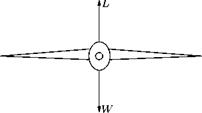Straight Side-Slip
 |
 |
Consider an aircraft flying steadily and horizontally, as shown in Figure 10.9(a), to be rolled through an angle ф from the vertical, as shown in Figure 10.9(b) and held in this position by controls. The lift will no longer balance the weight.
If the aircraft is supposed to be flying towards us so that the starboard wing is dipped, the aircraft will accelerate in the direction of the resultant of L and W, and will continue to accelerate until a steady state is reached owing to the wind blowing across the body and producing a side force in the direction of the span. The direction of motion is now inclined to the plane of symmetry at an angle в, say, measured positively when the direction of motion is to starboard. The aircraft is now moving crab-wise in the straight path and is said to be sideslipping. If V is the speed, the component of V sin в perpendicular to the plane of symmetry is called the velocity of side-slip.
Side-slip will neither diminish the drag nor increase the lift as compared to symmetrical flight at the same speed. If D’ and L’ are the drag and lift, respectively, in the steady side-slip induced by the above maneuver then L’ < L, D > D. The gliding angle у’ will be given by:
tan у’
or у’ > у. The effect of side-slip is therefore to increase the gliding angle without reducing the speed.













